ron TOYOTA CAMRY 2016 XV50 / 9.G Owners Manual
[x] Cancel search | Manufacturer: TOYOTA, Model Year: 2016, Model line: CAMRY, Model: TOYOTA CAMRY 2016 XV50 / 9.GPages: 568, PDF Size: 13.13 MB
Page 2 of 568
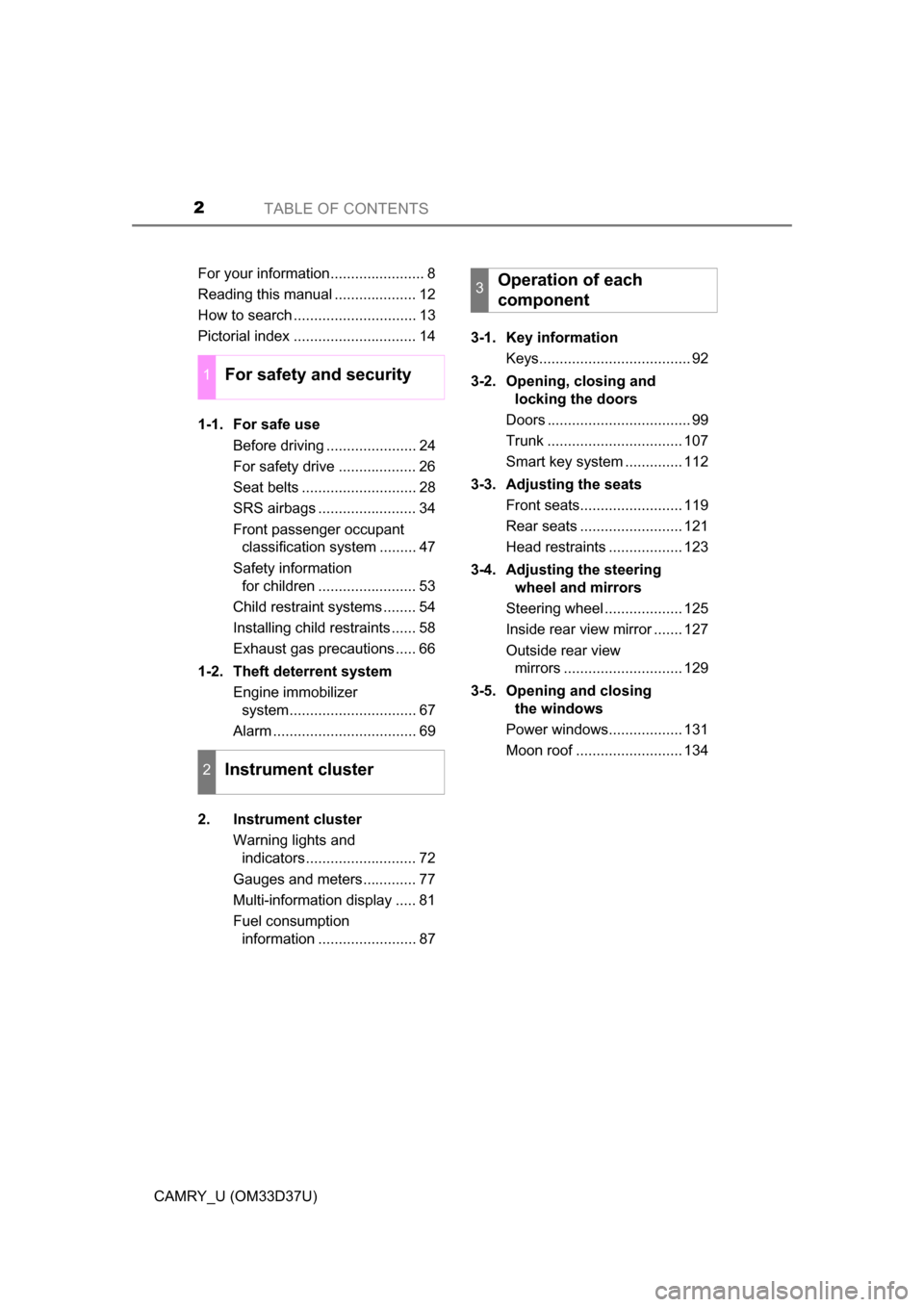
TABLE OF CONTENTS2
CAMRY_U (OM33D37U)For your information....................... 8
Reading this manual .................... 12
How to search .............................. 13
Pictorial index .............................. 14
1-1. For safe use
Before driving ...................... 24
For safety drive ................... 26
Seat belts ............................ 28
SRS airbags ........................ 34
Front passenger occupant classification system ......... 47
Safety information for children ........................ 53
Child restraint systems ........ 54
Installing child restraints ...... 58
Exhaust gas precautions ..... 66
1-2. Theft deterrent system Engine immobilizer system............................... 67
Alarm ................................... 69
2. Instrument cluster Warning lights and indicators........................... 72
Gauges and meters............. 77
Multi-information display ..... 81
Fuel consumption information ........................ 87 3-1. Key information
Keys..................................... 92
3-2. Opening, closing and locking the doors
Doors ................................... 99
Trunk ................................. 107
Smart key system .............. 112
3-3. Adjusting the seats Front seats......................... 119
Rear seats ......................... 121
Head restraints .................. 123
3-4. Adjusting the steering wheel and mirrors
Steering wheel ................... 125
Inside rear view mirror ....... 127
Outside rear view mirrors ............................. 129
3-5. Opening and closing the windows
Power windows.................. 131
Moon roof .......................... 134
1For safety and security
2Instrument cluster
3Operation of each
component
Page 6 of 568
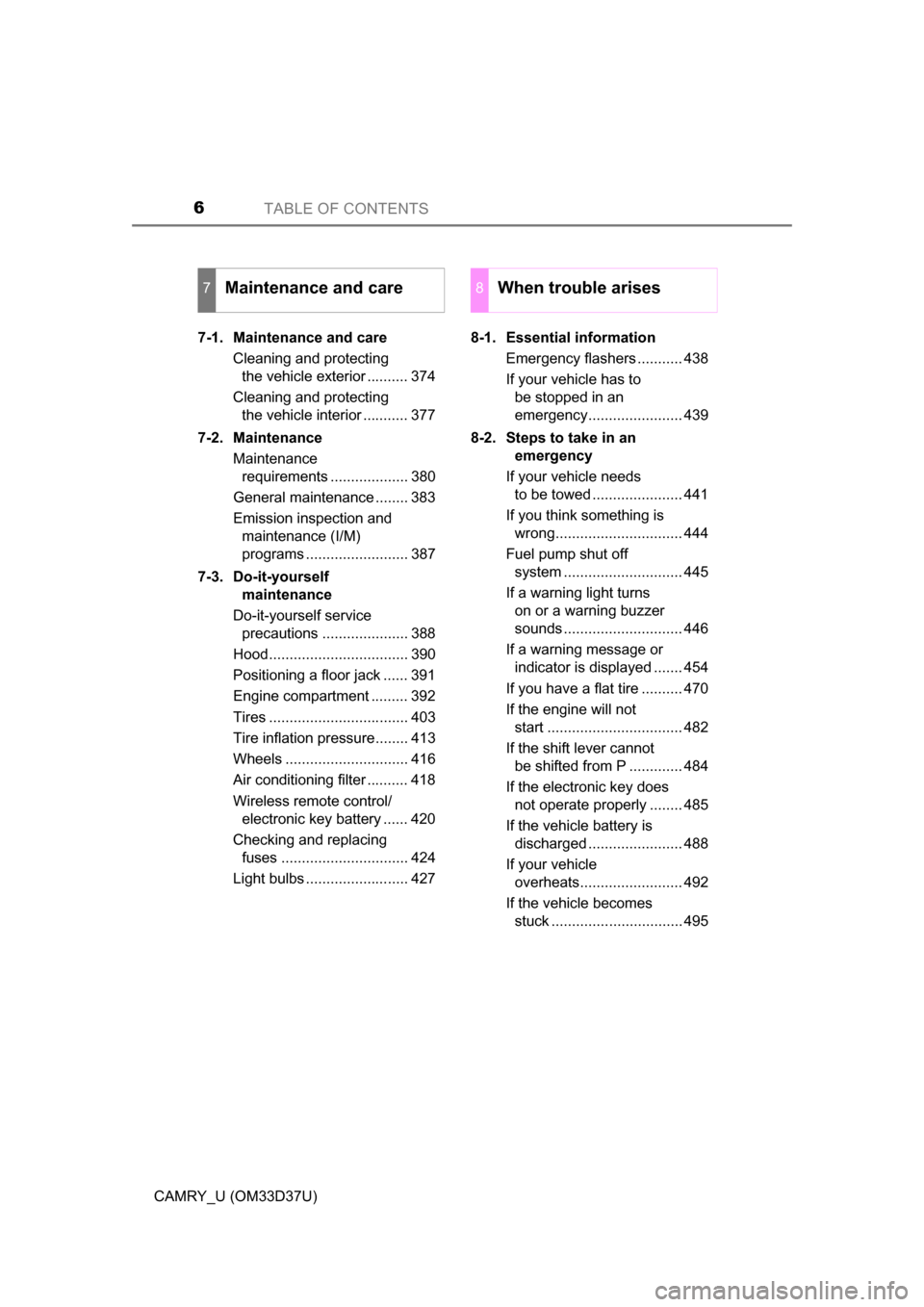
TABLE OF CONTENTS6
CAMRY_U (OM33D37U)7-1. Maintenance and care
Cleaning and protecting the vehicle exterior .......... 374
Cleaning and protecting the vehicle interior ........... 377
7-2. Maintenance Maintenance requirements ................... 380
General maintenance ........ 383
Emission inspection and maintenance (I/M)
programs ......................... 387
7-3. Do-it-yourself maintenance
Do-it-yourself service precautions ..................... 388
Hood.................................. 390
Positioning a floor jack ...... 391
Engine compartment ......... 392
Tires .................................. 403
Tire inflation pressure........ 413
Wheels .............................. 416
Air conditioning filter .......... 418
Wireless remote control/ electronic key battery ...... 420
Checking and replacing fuses ............................... 424
Light bulbs ......................... 427 8-1. Essential information
Emergency flashers ........... 438
If your vehicle has to be stopped in an
emergency....................... 439
8-2. Steps to take in an emergency
If your vehicle needs to be towed ...................... 441
If you think something is wrong............................... 444
Fuel pump shut off system ............................. 445
If a warning light turns on or a warning buzzer
sounds ............................. 446
If a warning message or indicator is displayed ....... 454
If you have a flat tire .......... 470
If the engine will not start ................................. 482
If the shift lever cannot be shifted from P ............. 484
If the electronic key does not operate properly ........ 485
If the vehicle battery is discharged ....................... 488
If your vehicle overheats......................... 492
If the vehicle becomes stuck ................................ 495
7Maintenance and care8When trouble arises
Page 8 of 568
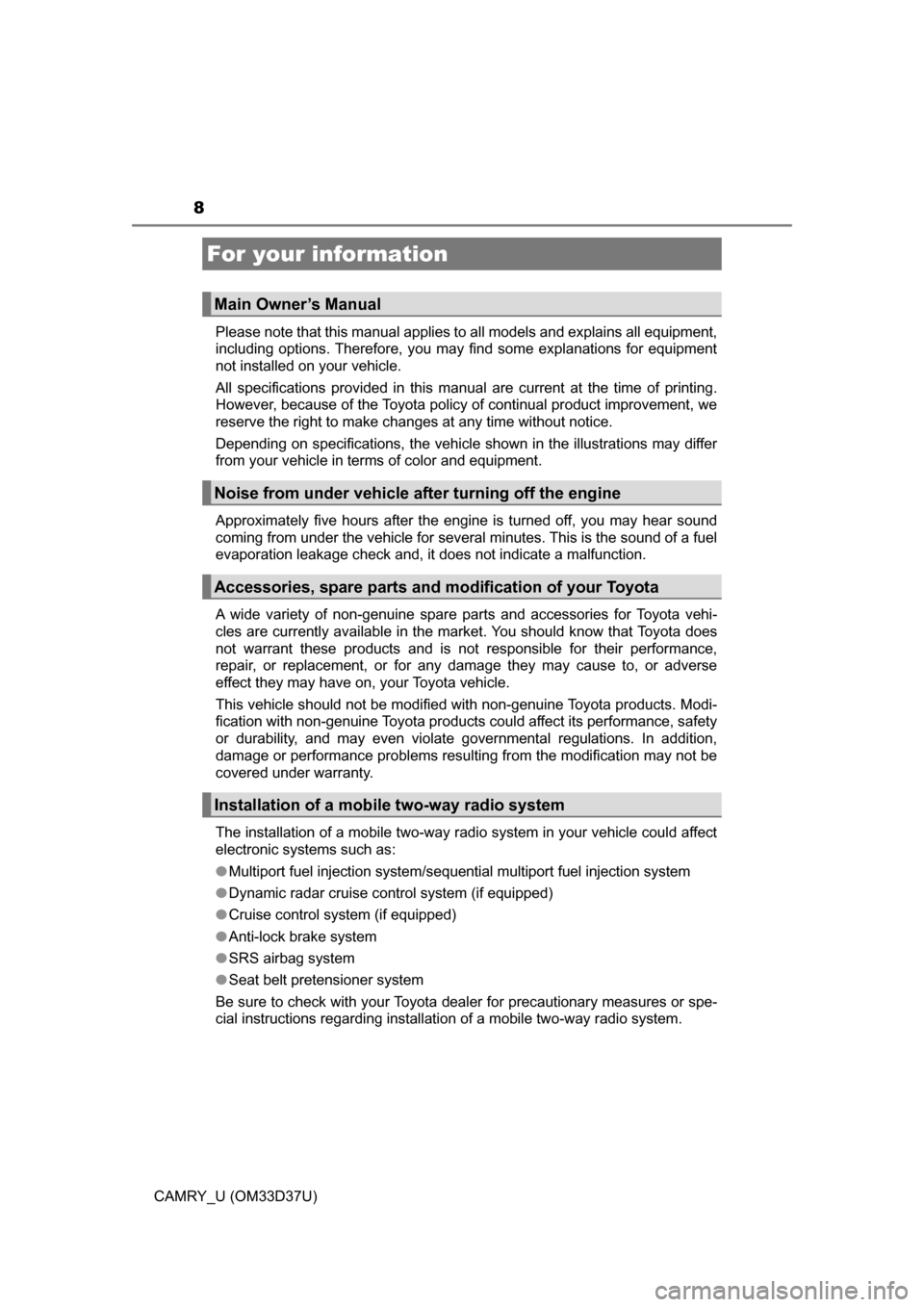
8
CAMRY_U (OM33D37U)Please note that this manual applies to all models and explains all equipment,
including options. Therefore, you may find some explanations for equipment
not installed on your vehicle.
All specifications provided in this manual are current at the time of printing.
However, because of the Toyota policy of continual product improvement, we
reserve the right to make changes at any time without notice.
Depending on specifications, the vehicle shown in the illustrations may differ
from your vehicle in terms of color and equipment.
Approximately five hours after the engine is turned off, you may hear sound
coming from under the vehicle for several minutes. This is the sound of a fuel
evaporation leakage check and, it does not indicate a malfunction.
A wide variety of non-genuine spare parts and accessories for Toyota vehi-
cles are currently available in the market. You should know that Toyota does
not warrant these products and is not responsible for their performance,
repair, or replacement, or for any damage they may cause to, or adverse
effect they may have on, your Toyota vehicle.
This vehicle should not be modified with non-genuine Toyota products. Modi-
fication with non-genuine Toyota products could affect its performance, safety
or durability, and may even violate governmental regulations. In addition,
damage or performance problems resulting from the modification may not be
covered under warranty.
The installation of a mobile two-way radio system in your vehicle could affect
electronic systems such as:
●
Multiport fuel injection system/sequential multiport fuel injection system
● Dynamic radar cruise control system (if equipped)
● Cruise control system (if equipped)
● Anti-lock brake system
● SRS airbag system
● Seat belt pretensioner system
Be sure to check with your Toyota dealer for precautionary measures or spe-
cial instructions regarding installation of a mobile two-way radio system.
For your information
Main Owner’s Manual
Noise from under vehicle after turning off the engine
Accessories, spare parts and modification of your Toyota
Installation of a mobile two-way radio system
Page 15 of 568

15Pictorial index
CAMRY_U (OM33D37U)Windshield wipers . . . . . . . . . . . . . . . . . . . . . . . . . . . . . . . . . P. 176
Precautions against winter season . . . . . . . . . . . . . . . . . . . . . P. 234
Fuel filler door . . . . . . . . . . . . . . . . . . . . . . . . . . . . . . . . . . . . P. 178
Refueling method . . . . . . . . . . . . . . . . . . . . . . . . . . . . . . . . . . . P. 178
Fuel type/fuel tank capacity . . . . . . . . . . . . . . . . . . . . . . . . . . . P. 500
Tires . . . . . . . . . . . . . . . . . . . . . . . . . . . . . . . . . . . . . . . . . . P. 403
Tire size/inflation pressure . . . . . . . . . . . . . . . . . . . . . . . . . P. 504
Winter tires/tire chains . . . . . . . . . . . . . . . . . . . . . . . . . . . . P. 234
Checking/rotation/tire pressure warning system
*. . . . . . . . P. 403
Coping with flat tires . . . . . . . . . . . . . . . . . . . . . . . . . . . . . . P. 470
Hood . . . . . . . . . . . . . . . . . . . . . . . . . . . . . . . . . . . . . . . . . . . . P. 390
Opening . . . . . . . . . . . . . . . . . . . . . . . . . . . . . . . . . . . . . . . . . . P. 390
Engine oil . . . . . . . . . . . . . . . . . . . . . . . . . . . . . . . . . . . . . . . . . P. 500
Coping with overheat . . . . . . . . . . . . . . . . . . . . . . . . . . . . . . . . P. 492
Warning message . . . . . . . . . . . . . . . . . . . . . . . . . . . . . . . . . . P. 455
Headlights/halogen daytime running lights
* . . . . . . . . . . . P. 166
Front turn signal/parking lights/
LED daytime running lights
* . . . . . . . . . . . . . . . . . . . . . . . . P. 166
Front side marker lights . . . . . . . . . . . . . . . . . . . . . . . . . . . . P. 166
Rear turn signal lights . . . . . . . . . . . . . . . . . . . . . . . . . . . . . . P. 164
Stop/tail lights/rear side marker lights . . . . . . . . . . . . . . . . P. 166
Back-up lights
Shifting the shift lever to R . . . . . . . . . . . . . . . . . . . . . . . . . . . . P. 160
License plate lights . . . . . . . . . . . . . . . . . . . . . . . . . . . . . . . . P. 166
4
5
6
7
Light bulbs of the exterior lights for driving
(Replacing method: P. 427, Watts: P. 506)
*: If equipped
8
9
10
11
12
13
14
Page 21 of 568
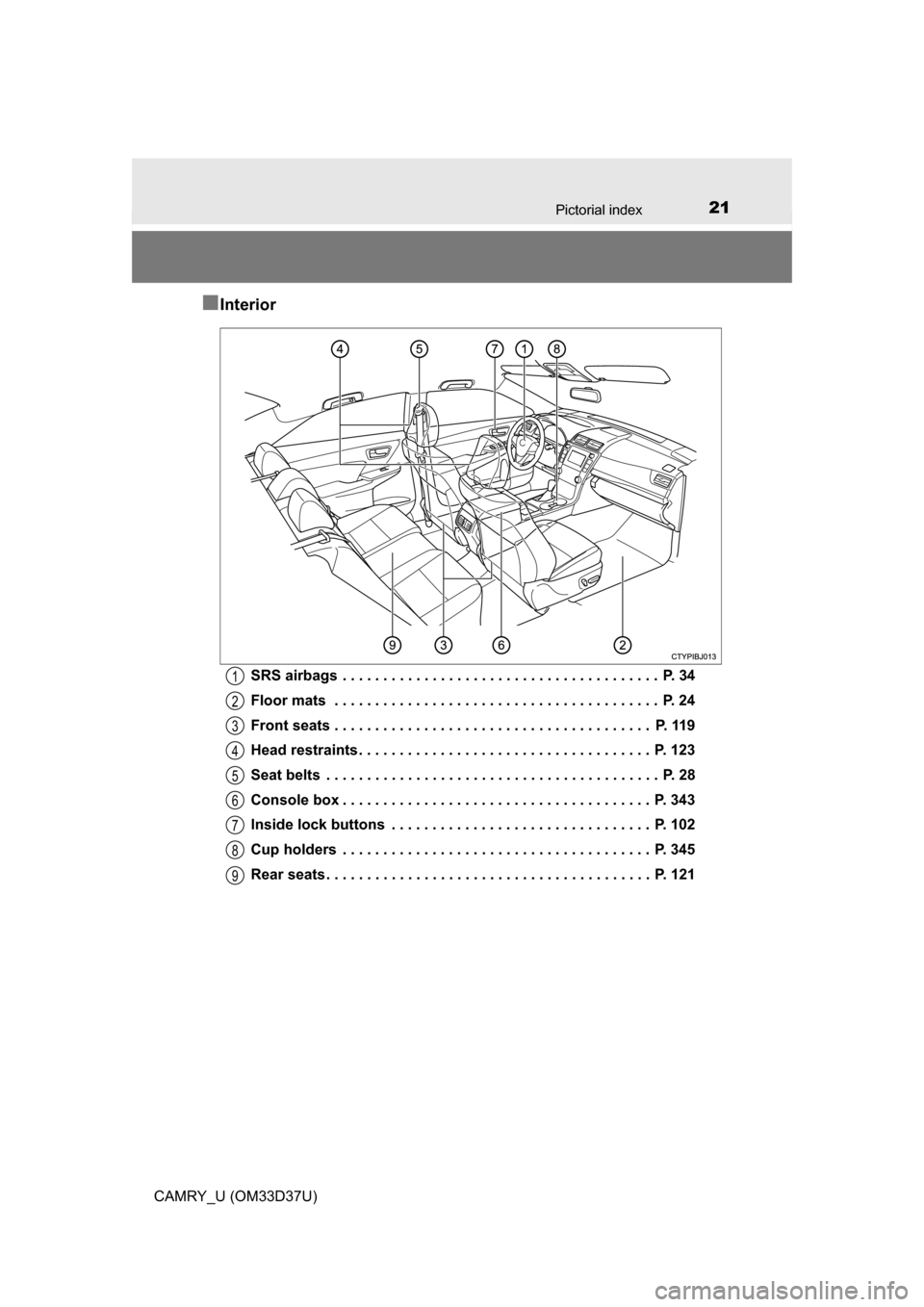
21Pictorial index
CAMRY_U (OM33D37U)
■Interior
SRS airbags . . . . . . . . . . . . . . . . . . . . . . . . . . . . . . . . . . . . . . . P. 34
Floor mats . . . . . . . . . . . . . . . . . . . . . . . . . . . . . . . . . . . . . . . . P. 24
Front seats . . . . . . . . . . . . . . . . . . . . . . . . . . . . . . . . . . . . . . . P. 119
Head restraints . . . . . . . . . . . . . . . . . . . . . . . . . . . . . . . . . . . . P. 123
Seat belts . . . . . . . . . . . . . . . . . . . . . . . . . . . . . . . . . . . . . . . . . P. 28
Console box . . . . . . . . . . . . . . . . . . . . . . . . . . . . . . . . . . . . . . P. 343
Inside lock buttons . . . . . . . . . . . . . . . . . . . . . . . . . . . . . . . . P. 102
Cup holders . . . . . . . . . . . . . . . . . . . . . . . . . . . . . . . . . . . . . . P. 345
Rear seats . . . . . . . . . . . . . . . . . . . . . . . . . . . . . . . . . . . . . . . . P. 1211
2
3
4
5
6
7
8
9
Page 23 of 568
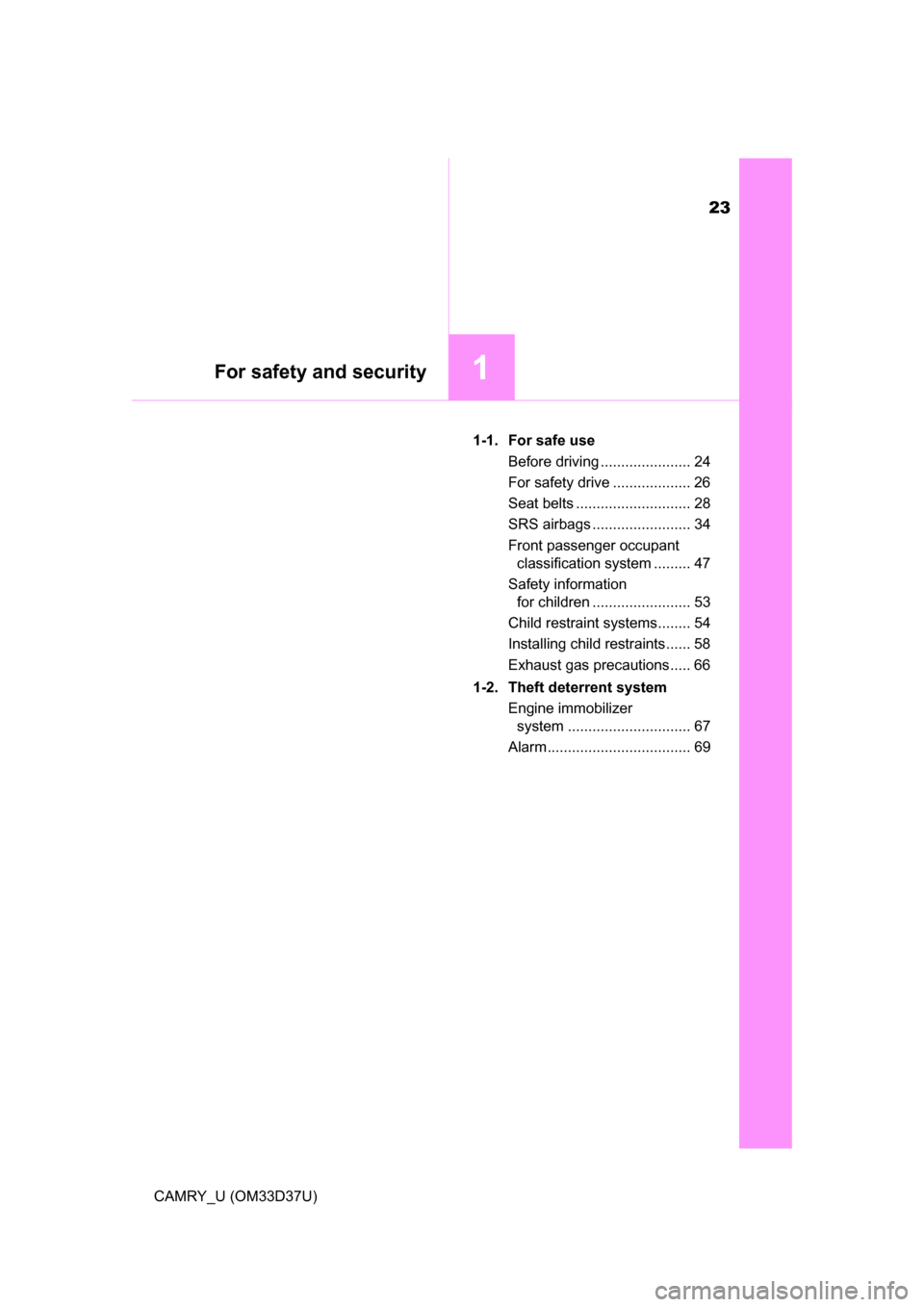
23
For safety and security1
CAMRY_U (OM33D37U)1-1. For safe use
Before driving ...................... 24
For safety drive ................... 26
Seat belts ............................ 28
SRS airbags ........................ 34
Front passenger occupant classification system ......... 47
Safety information for children ........................ 53
Child restraint systems........ 54
Installing child restraints...... 58
Exhaust gas precautions..... 66
1-2. Theft deterrent system Engine immobilizer system .............................. 67
Alarm................................... 69
Page 27 of 568

271-1. For safe use
1
For safety and security
CAMRY_U (OM33D37U)
Make sure that you can see backward clearly by adjusting the inside
and outside rear view mirrors properly. (P. 127, 129)
Adjusting the mirrors
WARNING
Observe the following precautions.
Failure to do so may result in death or serious injury.
● Do not adjust the position of the driver’s seat while driving.
Doing so could cause the driver to lose control of the vehicle.
● Do not place a cushion between the driver or passenger and the seatback.
A cushion may prevent correct posture from being achieved, and reduce
the effectiveness of the seat belt and head restraint.
● Do not place anything under the front seats.
Objects placed under the front seats may become jammed in the seat
tracks and stop the seat from locking in place. This may lead to an acci-
dent and the adjustment mechanism may also be damaged.
● When driving over long distances, take regular breaks before you start to
feel tired.
Also, if you feel tired or sleepy while driving, do not force yourself to con-
tinue driving and take a break immediately.
Page 29 of 568

291-1. For safe use
1
For safety and security
CAMRY_U (OM33D37U)
Push the seat belt shoulder
anchor down while pressing the
release button.
Push the seat belt shoulder
anchor up.
Move the height adjuster up and
down as needed until you hear a
click.
The pretensioners help the seat
belts to quickly restrain the occu-
pants by retracting the seat belts
when the vehicle is subjected to
certain types of severe frontal or
side collision or a vehicle rollover.
The pretensioners do not activate
in the event of a minor frontal
impact, a minor side impact or a
rear impact.
Adjusting the seat belt shoulder anchor height (front seats)
1
2
Seat belt pretensioners (front seats)
Page 32 of 568

321-1. For safe use
CAMRY_U (OM33D37U)
WARNING
■When children are in the vehicle
Do not allow children to play with the seat belt. If the seat belt becomes
twisted around a child’s neck, it may lead to choking or other serious injuries
that could result in death.
If this occurs and the buckle cannot be unfastened, scissors should be used
to cut the belt.
■ Seat belt pretensi oners (front seats)
● Do not place anything, such as a cushion, on the front passenger's seat.
Doing so will disperse the passenger's weight, which prevents the sensor
from detecting the passenger's weight properly. As a result, the seat belt
pretensioner for the front passenger's seat may not activate in the event of
a collision.
● If the pretensioner has activated, the SRS warning light will come on. In
that case, the seat belt cannot be used again and must be replaced at
your Toyota dealer.
■ Adjustable shoulder anchor (front seats)
Always make sure the shoulder belt is positioned across the center of your
shoulder. The belt should be kept away from your neck, but not falling off
your shoulder. Failure to do so could reduce the amount of protection in an
accident and cause death or serious injuries in the event of a sudden stop,
sudden swerve or accident. ( P. 29)
■ Seat belt damage and wear
● Do not damage the seat belts by allowing the belt, plate, or buckle to be
jammed in the door.
● Inspect the seat belt system periodically. Check for cuts, fraying, and loose
parts. Do not use a damaged seat belt until it is replaced. Damaged seat
belts cannot protect an occupant from death or serious injury.
● Ensure that the belt and plate are locked and the belt is not twisted.
If the seat belt does not function correctly, immediately contact your Toyota
dealer.
● Replace the seat assembly, including the belts, if your vehicle has been
involved in a serious accident, even if there is no obvious damage.
● Do not attempt to install, remove, modify, disassemble or dispose of the
seat belts. Have any necessary repairs carried out by your Toyota dealer.
Inappropriate handling may lead to incorrect operation.
● Always make sure the shoulder belt passes through the guide when using
the seat belt. Failure to properly position the belt may reduce the amount
of protection in an accident and could lead to death or serious injury in a
collision or sudden stop.
● Always make sure that the seat belt is not twisted, does not get caught in
the guide or the seatback and is arranged in the proper position.
Page 34 of 568
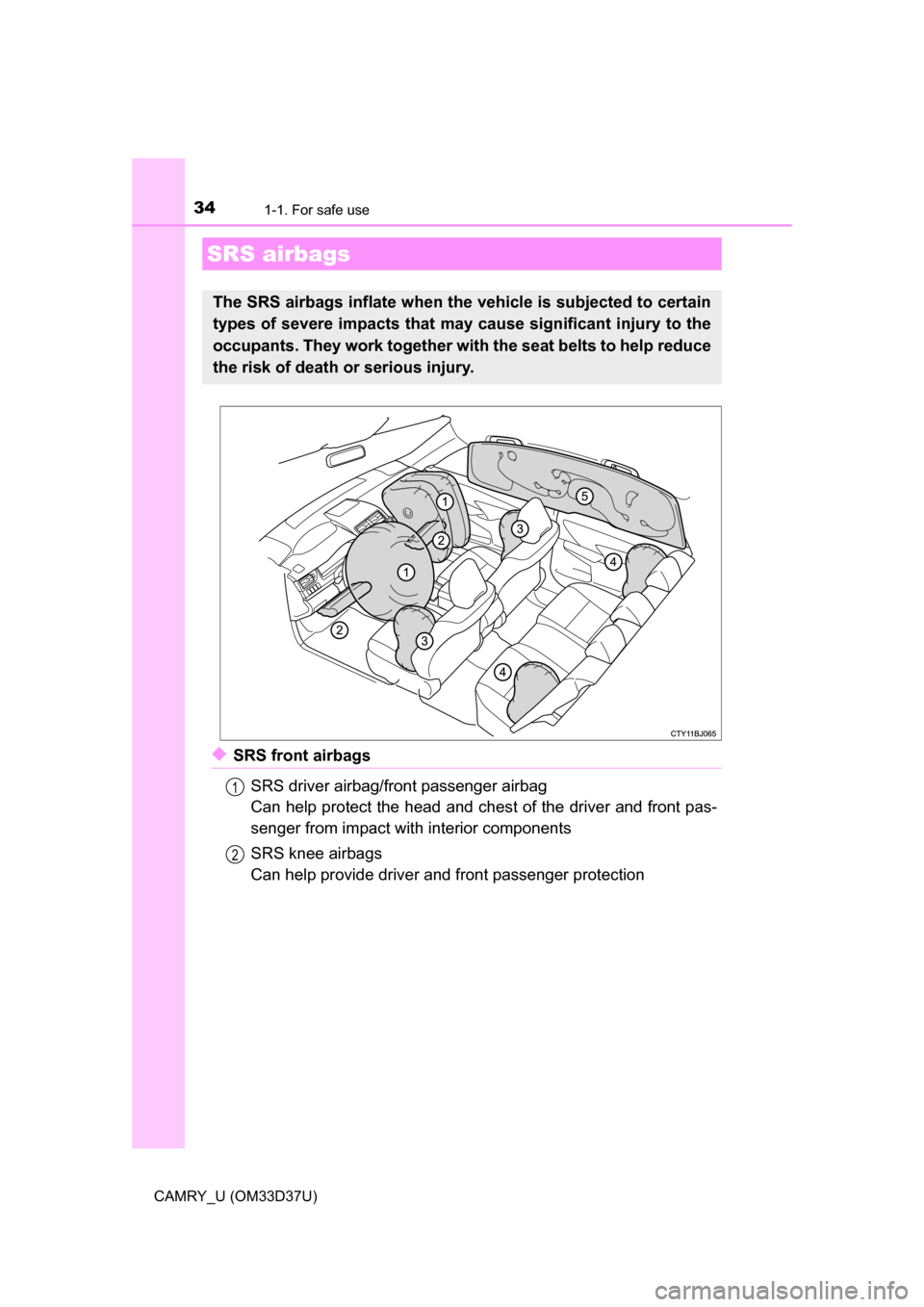
341-1. For safe use
CAMRY_U (OM33D37U)
◆SRS front airbagsSRS driver airbag/front passenger airbag
Can help protect the head and chest of the driver and front pas-
senger from impact with interior components
SRS knee airbags
Can help provide driver and front passenger protection
SRS airbags
The SRS airbags inflate when the vehicle is subjected to certain
types of severe impacts that may cause significant injury to the
occupants. They work together with the seat belts to help reduce
the risk of death or serious injury.
1
2